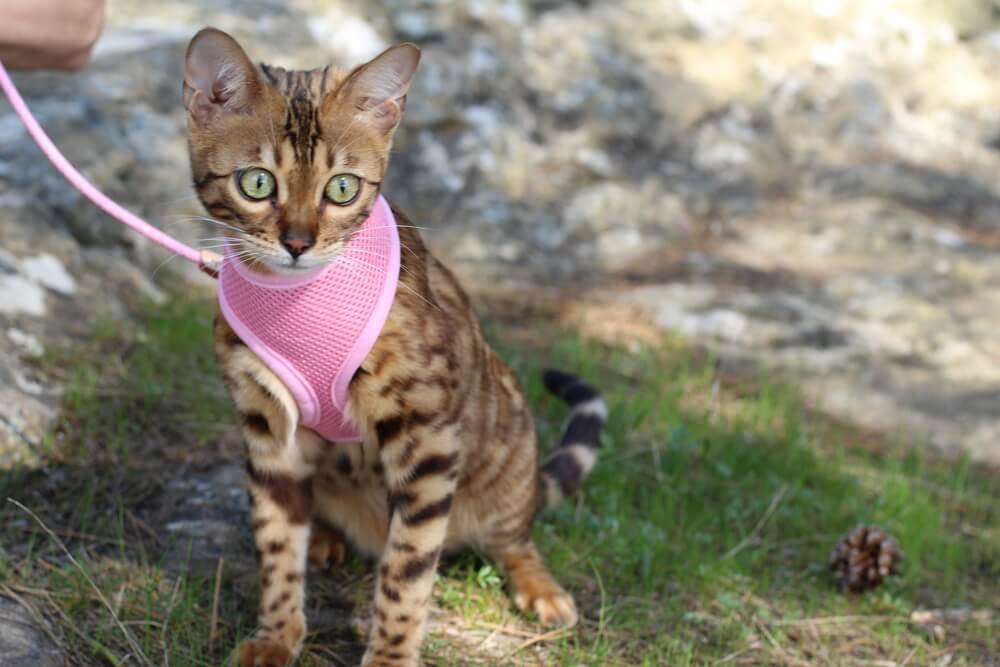Cats can be stubborn and resistant, so it’s not uncommon for them to become paralyzed with fear when a harness is put on them. The sudden confinement of cats usually triggers this behavior feel once the harness is in place.
The tightness of the straps, combined with the feeling that their movement is restricted, can cause them to freeze up in an attempt to protect themselves from what they perceive as a danger, even if there isn’t any real risk involved.
Additionally, cats may have had past experiences with being held or restrained, which further contributes to this defensive reaction.
It’s important to understand that this behavior does not indicate disobedience or stubbornness. It’s simply a natural response to fear and can be addressed through positive reinforcement training.
With the right approach, cats can become more comfortable wearing a harness and eventually learn to associate it with pleasant experiences instead of feeling scared and paralyzed when they put one on.
This can help make walks safer, allowing them to enjoy all the great benefits that come from being outdoors in a supervised environment. In this way, owners can ensure their cat’s safety while still allowing them to experience nature firsthand.
Harnessing your cat may seem like an uphill battle at first but with patience and perseverance, you can help them overcome their fear and learn how to be comfortable with wearing a harness. With the right training, cats can benefit from regular outdoor outings with their owners just like any other pet.
Why Do Cats Walk Weird With a Harness?
It’s common for cats to walk strangely or erratically when wearing a harness. This can be caused by the unfamiliar sensation of having their movement restricted by the straps, which may lead them to try to adjust and compensate for it in strange ways.
Additionally, the fear of being restrained may cause them to feel a heightened sense of alertness which can further contribute to their odd behavior.
To help your cat become more comfortable with walking in a harness, it’s important to make sure they are gradually introduced to the experience.
Make sure they have ample time and space during walks so that they don’t feel trapped or overwhelmed. Try rewarding good behavior with treats or toys as reinforcement training can be very effective in helping cats become more relaxed when wearing a harness.
By slowly getting them used to the experience and building positive associations, you can make walks in a harness much more enjoyable for both of you.
With patience and encouragement, cats can learn how to walk easily while wearing a harness and gain access to all the great benefits of outdoor adventures!
Harness training may take some time but it’s worth the effort as it will ultimately provide your cat with an enriching and safe way to enjoy their natural environment. Owners and cats can benefit from regular outings together by taking the proper steps!
Why Can’t Cats Jump With Harnesses?
Cats are known for their agility and jumping abilities, so it can be a shock when they’re unable to do even the simplest of jumps while wearing a harness.
This is due to the additional weight and feeling of confinement that comes with wearing one which can make leaping or climbing difficult or even impossible.
The key to helping your cat become more comfortable with jumping in a harness is to start slow and gradually increase the difficulty as they get used to it.
Introduce obstacles like small logs or steps that your cat needs to jump over and use treats or toys as rewards every time they successfully make it across.
By doing this regularly, you can help teach them how to trust their senses even while wearing a harness. Over time, they will gain confidence and eventually be able to jump with ease while wearing one.
Harnessing your cat may seem intimidating at first but it doesn’t have to be. By gradually introducing your kitty to the experience, you can help them become comfortable wearing a harness and enjoy outdoor activities together!
With patience, understanding, and plenty of positive reinforcement training, both cats and their owners can benefit from regular outings on walks or hikes in nature without sacrificing safety. So don’t hesitate to give it a try! Your cat will thank you for it!
How Do You Harness a Stubborn Cat?
It’s not unusual for cats to be stubborn when it comes to wearing a harness, but with patience and the right training methods, you can help them overcome their fear.
The key is to start slow and take your time in introducing them to the experience. Begin by placing the harness on them while they’re sitting or laying down, then slowly build up to walking as they become more comfortable with it.
During this process, make sure you reward all good behaviors with treats or toys and use plenty of positive reinforcement training. This will help create an associative link between wearing a harness and something fun or pleasant which can go a long way in helping your cat relax during walks.
Additionally, keep an eye out for signs that they are becoming anxious or overwhelmed and adjust the training accordingly. If your cat isn’t ready to take a walk yet, try letting them wear the harness around the house for brief periods until they become more comfortable with it.
Conclusion
With patience and understanding, you can help your stubborn cat learn how to trust their senses even while wearing a harness.
With regular outings and lots of positive reinforcement, both owners and cats alike can benefit from outdoor adventures together! So don’t give up just yet – with the right methods, even the most stubborn cats can eventually learn how to love walking in a harness!












